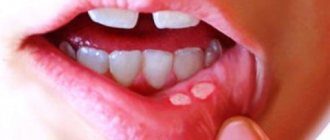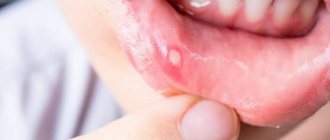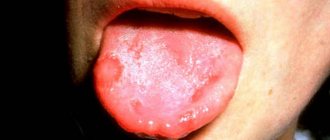Bacterial stomatitis: before and after photos
The causes of infection may be:
- pockets of bacteria accumulation on carious teeth;
- germs entering the mouth due to herpes;
- infection during treatment - bacterial stomatitis can develop if the doctor does not comply with antiseptic rules;
- chronic diseases of various organs;
- contact with a sick person (for example, a kiss).
Symptoms of infectious stomatitis are, first of all, redness of the oral mucosa in the place where microbes entered the wound, swelling, and in the necrotic form, a rash. In children, cracks may form in the mucous membrane, and the gums begin to bleed. The damaged area is itchy and painful.
If bacterial stomatitis is not treated, the temperature rises, a headache appears, the lymph nodes and tonsils become inflamed, and due to intoxication of the body, the rash spreads throughout the body. Children may develop a sore throat and experience pain in the knee joints.
Prevention of stomatitis
You can reduce the risk of developing stomatitis using the following recommendations:
- regular washing of toys, bottles, pacifiers, breast hygiene if the baby is breastfed;
- general strengthening activities: walks, wet cleaning, a balanced diet, moderate hardening, adherence to a daily routine;
- fighting bad habits of biting nails, pencils, etc.;
- regular dental examinations and timely interventions in case of dental injuries.
The dentists of the Family Doctor clinic treat and prevent stomatitis in children.
Advanced equipment allows us to quickly and accurately assess the condition of the oral cavity and perform the necessary studies in a short time. We practice modern approaches to the treatment of inflammatory diseases of the oral cavity and adhere to an individual approach to each small patient. Consultations with a pediatric dentist are available by appointment. To make an appointment, call the single contact center or fill out a special online appointment form with a pediatric dentist on the website, or you can also visit the clinic’s reception in person.
Treatment of bacterial stomatitis
Self-medication for infectious stomatitis is completely excluded, since it is necessary to accurately identify the pathogen and select drugs that suppress it. Such studies are carried out in the laboratory. This is especially important when it comes to babies. To prevent possible complications, parents of a baby should immediately consult a doctor as soon as they see an inflamed scratch or swelling in the child’s mouth.
When treating bacterial stomatitis, the following are used:
If necrosis has developed, dead tissue is removed surgically, after which it is necessary to completely sanitize the oral cavity.
In parallel with medical measures to eliminate the symptoms of bacterial stomatitis, the patient is prescribed a diet. During this period, it is necessary to ensure maximum sparing of the oral mucosa, limit the consumption of carbohydrates and enrich the diet with vitamins and proteins.
- Superficial (catarrhal). In this case, symptoms of intoxication manifest themselves in a deterioration in appetite and an increase in temperature. There is discomfort when chewing and swallowing food, and the secretion of saliva periodically increases. When examining the oral cavity, a white coating on the tongue is found (on its lateral surfaces there are clearly visible imprints of teeth), bleeding gums, and hyperemia of the mucous membrane. Lack of treatment for catarrhal bacterial stomatitis leads to the disease progressing to the next, more severe form.
- Deep (ulcerative-necrotic). The patient's condition worsens. Symptoms of intoxication intensify: a person has a headache, the temperature rises to high levels, sleep and appetite are disturbed, weakness, irritability, and lethargy appear. Also, bacterial stomatitis in this form is characterized by pain when chewing, bad breath, and increased salivation. When examining the oral cavity, bleeding gums, hyperemia of the mucous membranes, and the presence of ulcers are revealed - first small, covered with a grayish coating, then enlarged, deep, with traces of tissue decay. Immunostimulants. They are necessary to boost immunity and prevent new outbreaks of the disease. These drugs have local and general effects. The doctor selects the optimal treatment option depending on the patient’s condition. For the same purpose, it is recommended to take a course of vitamins.
- Antibiotics. They are prescribed when bacterial stomatitis has become severe or the cause of the disease is systemic diseases of the internal organs. Effective remedies that stop infection directly in the oral cavity are ointments that contain an antibiotic. They give excellent results if the causative agent is a coccal infection. Among the drugs for oral administration in the treatment of bacterial stomatitis, penicillin, lincomycin, gentamicin, kanacimin and others are used.
- Antiseptics. At the initial stage and in the middle of the disease, rinsing with a chlorhexidine solution and treating the mucous membranes of the oral cavity with an anti-inflammatory gel with an analgesic effect are recommended. After the disappearance of acute symptoms, treatment of bacterial stomatitis continues with the help of epithelializing agents that promote rapid healing of defects.
Classification of the disease
Before starting treatment for herpes stomatitis, it is necessary to determine the form and degree of its progression. At the same time, acute herpetic stomatitis in children is diagnosed already when the virus first enters the body.
The severity of the disease is divided into:
- Light. Small blisters form on the oral mucosa - they quickly disappear after they rupture;
- Average. The rashes are more extensive, body temperature rises (up to 38º);
- Heavy. The patient has an abundance of ulcers in his mouth, and after they disappear, new ones appear. Symptoms are supplemented by fever, headache and chills, sometimes the patient feels sick and has diarrhea.
In the absence of proper treatment, chronic recurrent herpetic stomatitis develops. This form of the disease is already characterized by group rashes (on the inside of the cheeks, tongue and palate). The formations combine and form painful erosions. In the recurrent stage, except for rashes, no other symptoms of the disease are noted. The disease may return 2-6 months after treatment.
Forecast and prevention of the disease
If you consult a doctor in a timely manner, the treatment prognosis is favorable. Strict adherence to the doctor’s recommendations allows you to achieve remission.
The main prevention of stomatitis is maintaining oral hygiene. In order not to injure the mucous membrane, it is recommended not to use a hard brush. From time to time it is worth using pastes with an anti-inflammatory effect (contain oak bark).
After each meal you need to rinse your mouth with an herbal solution or special compositions. Regular visits to the dentist twice a year increases the chance of noticing the first manifestations of the disease.
It is the responsibility of parents to ensure that the child washes his hands frequently and thoroughly with soap and rinses vegetables and fruits before eating them.
Forms of aphthous stomatitis in adults
There are two forms of the disease:
- chronic;
- spicy.
In acute aphthous stomatitis, round whitish ulcers appear. The mucous membrane swells and turns red.
This form of the disease has the following symptoms:
- pain when eating;
- body temperature rises;
- weakness and a feeling of fatigue occurs, regardless of the work performed;
- lymph nodes become inflamed.
The stage lasts a maximum of ten days, provided that the treatment prescribed by the doctor is followed. The ulcers heal completely without leaving any marks behind. If no action is taken, the disease can progress to a chronic stage, which is much more difficult to get rid of.
Chronic stomatitis is associated with an immune system that is unable to overcome the acute stage. In most cases, a decrease in the protective properties of the immune system is caused by some disease (for example, inflammation of the nasopharynx, gastrointestinal diseases, etc.). Treatment takes longer because after the ulcers disappear, they appear again after some time.
Aphthous stomatitis in children: treatment
Treatment of aphthous stomatitis in children is no different from treatment of this disease in adults.
Since in most cases it is not possible to establish the exact cause of stomatitis, treatment will be multifocal, that is, several drugs will be used simultaneously.
The choice of treatment regimen will depend on the following factors:
- severity of symptoms;
- how often do symptoms of the disease appear;
- Are there factors predisposing to the development of the disease?
At the initial stage, treatment is always aimed at reducing the patient’s pain, at further stages - at healing the ulcers as quickly as possible and preventing their occurrence in the future.
All patients are divided into three groups:
- stomatitis occurs no more than a couple of times a year, the pain is low. As a rule, in this case, the provoking factors may be incorrectly installed fillings or the use of products with sodium lauryl sulfate. The child is advised to avoid solid and spicy foods, minimize the consumption of sour juices and chocolate. Treatment of such patients involves the use of antiseptic rinses and gels that reduce pain.
- chronic aphthous stomatitis, which occurs on a monthly basis and forces a person to change habits (for example, brushing teeth less often due to pain). Provoking factors are identified in order to eliminate them. The physician advises the patient to understand the signs of an imminent outbreak so that topical treatments can be used before ulcers occur.
- ulcers appear constantly (the previous ones do not have time to heal before the next ones appear) and are extremely painful. Local therapy in this case is practically useless - only systemic therapy helps.
Causes
There is still no consensus on why aphthous stomatitis occurs. However, most doctors believe that the main reason for the development of the disease is weakened immunity.
Often the occurrence of stomatitis is a consequence of other diseases: influenza, tonsillitis, tonsillitis, gastrointestinal diseases. Provoking factors include a sharp change in climate zone and a large amount of stress in everyday life.
Many microorganisms enter the human body through the oral cavity: a decrease in the overall immunity of the body entails a decrease in the level of resistance of the mucous membrane. As a result, the concentration of microbes in the mouth increases, the result of which is the development of the disease.
Types of stomatitis
In medicine, it is customary to distinguish two types of stomatitis:
- acute gingivostomatitis, which is caused by various viral infections;
- recurrent stomatitis (caused by staphylococci, immune diseases and problems with the gastrointestinal tract). As the name suggests, the disease tends to occur again and again - periods of exacerbation occur in autumn and spring, when there is a lack of vitamins.
Separately, it is worth highlighting herpetic stomatitis, which affects not only the immune system, but also the nervous system. It occurs most often in children under 3 years of age: during this period, firstly, the influence of maternal immunity on the baby’s body rapidly weakens, and secondly, the child begins to go to kindergarten, where he interacts with other children who may already be infected with the virus herpes.
What is aphthous stomatitis
The exact mechanisms of development of aphthous stomatitis are still unknown.
It is generally accepted that with aphthous stomatitis, the infection enters the oral cavity, but does not cause a protective reaction in the body's immune cells. They simply do not recognize the pathogen. The infection changes the composition of saliva, this causes the activity of lymphocytes and the immune system attacks areas of the oral mucosa as a foreign chemical agent.
As a result of this confrontation, erosions form on the mucous membrane.
Aphthae have a round or oblong shape with a diameter of up to 5 mm. Outwardly, they resemble ulcers, covered with a white or gray coating and outlined with a red rim. On the mucous membrane, aphthae are located in groups or separately.
If more than three canker sores have formed in the mouth, this is a severe form of stomatitis. Despite their small size, the ulcers are painful and interfere with eating and talking. With stomatitis, the temperature may rise and weakness may appear.
If a person's immune system is weak, it will continue to interpret the presence of foreign chemicals in the mouth as a danger and canker sores will become chronic. Therefore, it is important to start treatment of aphthous stomatitis on time and carry it out under the supervision of a doctor.










